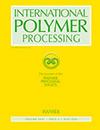Vibration damping properties of graphene nanoplatelets filled glass/carbon fiber hybrid composites
IF 1.9
4区 工程技术
Q4 ENGINEERING, CHEMICAL
引用次数: 1
Abstract
Abstract The present study investigates the effect of carbon fiber hybridization and graphene nanoplatelets inclusion on the vibration damping properties of glass fiber reinforced polymer composites. The hand layup method was utilized with hot press molding in hybrid/non-hybrid composite plate production. A total of sixteen laminates, eight containing pure glass/epoxy and pure carbon/epoxy, and the remainder containing glass/carbon, were stacked in four different arrays and impregnated with an epoxy matrix to provide a hybrid/non-hybrid configuration. In the first hybrid configuration, the glass fiber fabric is on the outer surface and the carbon fiber fabric is on the inside of the composite plate; in the second configuration, the opposite of this sequence was used. Graphene Nanoplatelets (GNPs) were added into the epoxy resin in different weight fractions (0, 0.1, 0.25, and 0.5 wt%). Experimental modal analysis was performed to evaluate the natural frequency and damping ratios of the GNPs modified/unmodified test samples. According to the results obtained, carbon fiber hybridization not only increased the natural frequency but also caused a decrease in the damping ratio of the glass fiber reinforced composite material. On the other hand, incorporating 0.5% by weight of GNPs into the epoxy matrix improved damping ratios by approximately 42.1, 51.6, 16.7 and 17.2% for the G05, GC05, CG05 and C05 samples, respectively, compared to the pure samples. Also, a decrease in natural frequency and loss storage values were observed at high GNPs content.石墨烯纳米片填充玻璃/碳纤维混杂复合材料的减振性能
摘要研究了碳纤维杂化和石墨烯纳米片对玻璃纤维增强聚合物复合材料减振性能的影响。在混合/非混合复合板生产中,采用热压成型的手工叠层方法。总共16个层压板,其中8个含有纯玻璃/环氧树脂和纯碳/环氧树脂,其余的含有玻璃/碳,被堆叠成四个不同的阵列,并用环氧树脂基体浸渍,以提供混合/非混合配置。在第一混合配置中,玻璃纤维织物在复合板的外表面上,碳纤维织物位于复合板的内侧;在第二种配置中,使用了与此顺序相反的顺序。将石墨烯纳米板(GNP)以不同的重量分数(0、0.1、0.25和0.5wt%)加入到环氧树脂中。进行了实验模态分析,以评估GNP改性/未改性试样的固有频率和阻尼比。根据所获得的结果,碳纤维杂化不仅增加了玻璃纤维增强复合材料的固有频率,而且导致了阻尼比的降低。另一方面,与纯样品相比,将0.5%重量的GNP掺入环氧树脂基体中,G05、GC05、CG05和C05样品的阻尼比分别提高了约42.1%、51.6%、16.7%和17.2%。此外,在高GNP含量下,观察到固有频率和损耗存储值的降低。
本文章由计算机程序翻译,如有差异,请以英文原文为准。
求助全文
约1分钟内获得全文
求助全文
来源期刊

International Polymer Processing
工程技术-高分子科学
CiteScore
2.20
自引率
7.70%
发文量
62
审稿时长
6 months
期刊介绍:
International Polymer Processing offers original research contributions, invited review papers and recent technological developments in processing thermoplastics, thermosets, elastomers and fibers as well as polymer reaction engineering. For more than 25 years International Polymer Processing, the journal of the Polymer Processing Society, provides strictly peer-reviewed, high-quality articles and rapid communications from the leading experts around the world.
 求助内容:
求助内容: 应助结果提醒方式:
应助结果提醒方式:


